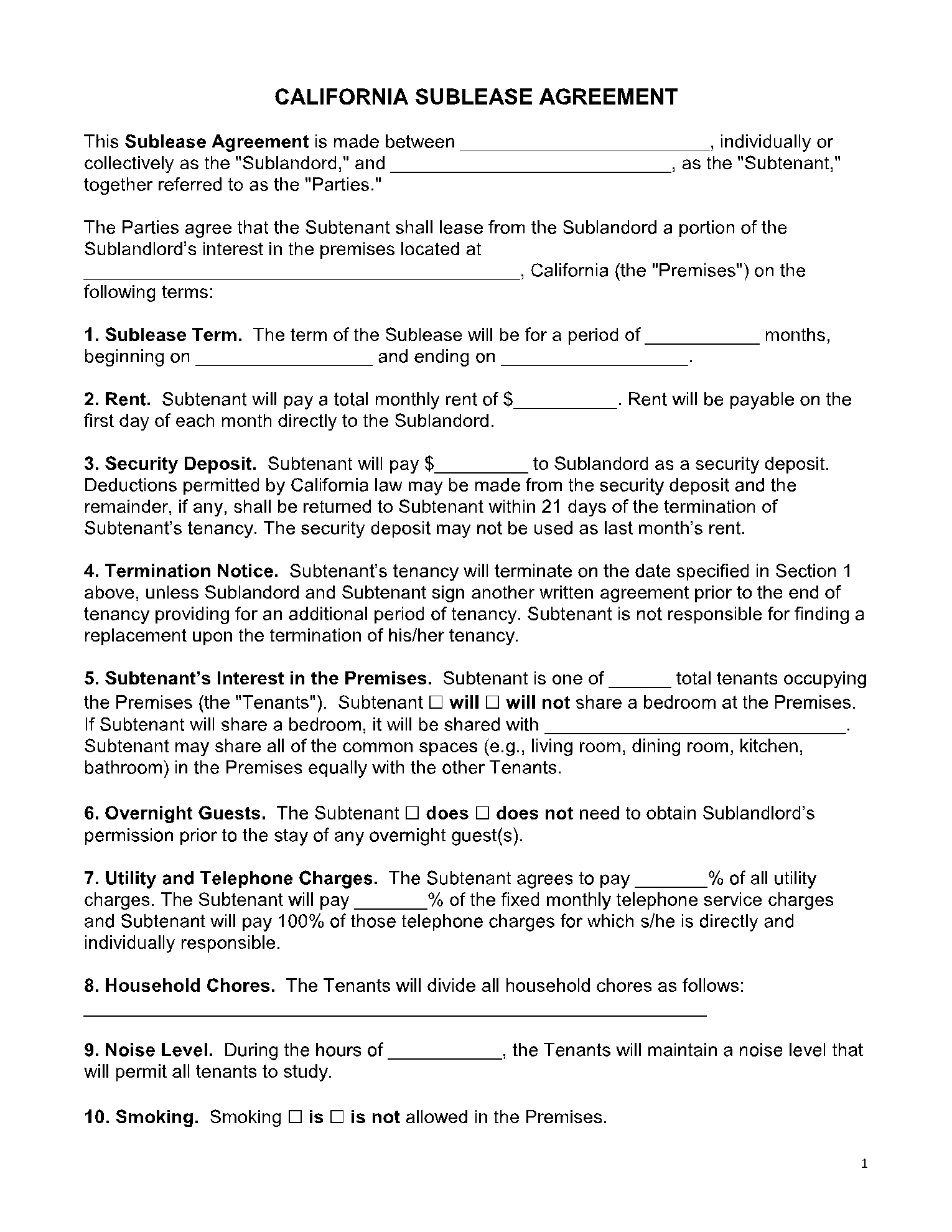In the commercial industry, business tenants may sublease or assign space to help with rental costs and to avoid being punished for ending their commercial lease quicker than a fixed term allows.
Whether a company has simply discontinued its office space or cannot make ends meet, transferring lease rights to a third party may be the only answer to filling the duties of their tenancy.
What is a California Sublease Agreement?
Using a California sublease agreement, you can lease a property that you may no longer require or a portion of a property that you also utilize. A sublease agreement in California is long-term, sometimes up to ten years, and includes expensive penalties for ending the lease early. For this reason, many tenants may benefit from a commercial sublease agreement in California.
- Use the California Commercial Sublease agreement if: You want to lease part of your space that you are leasing.
- You want to sublease the whole property that you still hold a lease on.
Why should I Sublease?
If your Lease Agreement says you can sublet the property, you may think of subletting all or part of the property if you are looking to reduce rent charges, or you want to move to another property, or you are going out for business. You may also choose to sublet multiple businesses.
You may require a Commercial Sublease if:
- You have a periodic business and want to cut expenses during the off-season.
- You are an entrepreneur and want to give your space to other business people to save capital.
- You had a change in the situation and no longer need to use your rental space but are still tied to a lease.
- You work with other experts or contractors as members of your business and wish to share expenses.
California Sublease Laws
You should review your original lease agreement to see if you’re allowed to sublease your property. It’s suggested that a tenant get written approval from their landlord before subletting in California.
Once you’ve filled out a California sublease agreement, you will completely be responsible for your subtenant.
A sublessor must accept the terms of the sublease agreement like the original lease and obey all California laws about the eviction process, security deposits, and all other landlord-tenant concerns.
California Landlord-Tenant Laws
Multiple Sections of the Laws of California
In California, a sublessor must:
- Give a 3 days notice to the subtenant to pay rent or leave
- Pay the security deposit within twenty-one days of the end of the sublease
- Depending on whether the subtenant has lived at the rental for under one year or over one year, provide a minimum of thirty days written notice of your intention to not renew the sublease or original lease
How to Write a California Sublease Agreement?
- Identify the parties —Provide the full name of both the sublessor and sublessee.
- List the address —State the full address of the property, along with the particular section being subleased (like a hall or the basement).
- Define the lease term —If it’s a fixed-term sublease, include the start and end date. If it’s month-to-month, note this as well as the amount of advance notice the subtenant and sublessor must give before leaving the property or ending the sublease.
- Identify the rent amount and terms —California law enables a landlord to increase the rent if you want to sublease, so be sure that you’re collecting sufficient rent to reach this new amount. Provide the amount of rent, when it’s due, and how it will be paid - by cash or cheque.
- Identify other financial responsibilities —In the sublease, add information about the utilities the subtenant is accountable for paying, such as electricity, phone, gas, water, trash collection, TV cable, internet, etc.
- Know the security deposit —Give the amount of the security deposit, and the reasons the sublessor may hold the security deposit in part or in full.
- List other restrictions —You can add other terms that are legal under California law, such as visitor policies, smoking policies, or related policies.
- Sign and date the agreement —In addition to yourself and the subtenant signing the sublease, you should have your landlord sign their approval to the sublease as well as a witness to the sublessee’s signature.
- Attach the original lease —Attach the original lease to the sublease, and make a note in the sublease that the rules of the original lease will also apply to the subtenant. Save spaces for signatures or initials showing that both parties are aware that the original lease was attached to the sublease.
Conclusion
As a tenant, the best choice will finally depend on your current situation and requirements. You will need to weigh the profits and outcomes of each form of transfer, as well as the authenticity of the third party. You must strictly follow the terms of your agreement to get out of a sublease agreement in California.
